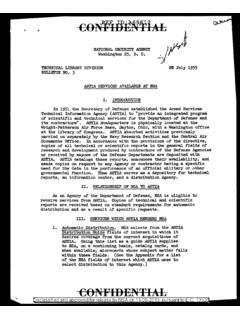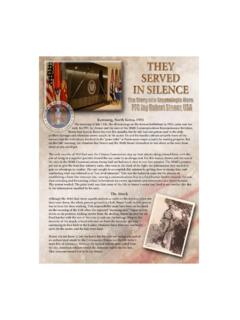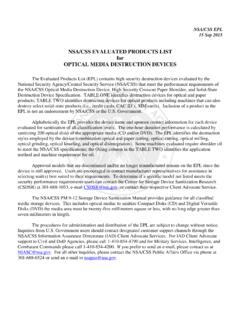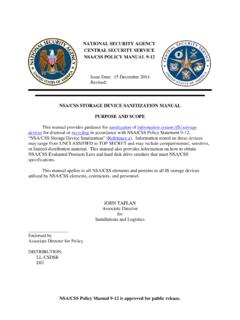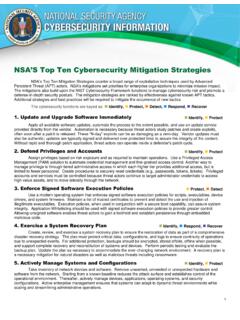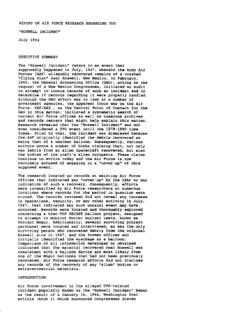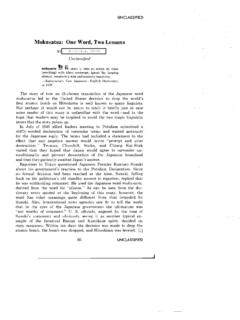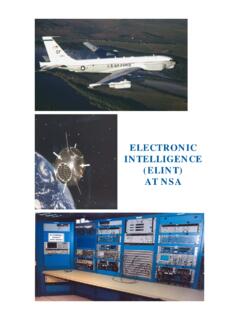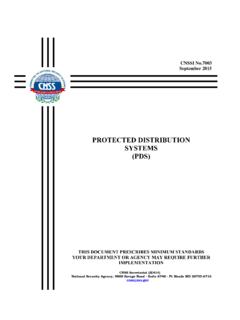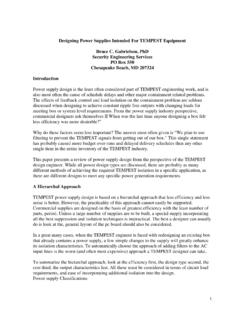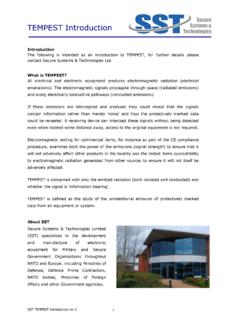Transcription of TEMPEST: A Signal Problem
1 ,i ,, "i 11 I \ I S CR 'f (b) (3) 86-36 tempest : A Signal Problem The story of the discovery of various compromising radiations from communications and Comsec equipment. In 1962, an officer assigned to a very smaJI intelligence detachment in Japan was performing the routine duty of inspecting the area around his little cryptocenter. As re<Juired, he was examining a zone 200 ft. in radius to see if there was any "'clandestine technical surveillance." Across the street, perhaps a hundred feet away, was a hospital controlled by the Japanese government. He sauntered past a kind of carport jutting out from one side of the building and, up under the eaves, noticed a peculiar thing-a carefully concealed dipole antenna, horizontaJly polarized.
2 With wires leading through che solid cinderblock wall co which the carport abutted. He moseyed back to his headquarters, then quickly notified the counter-intelligence people and fired off a report of this "find'" to Army Securi-ty Agency, who, in turn, notified NSA. He was directed to examine this antenna in detail and perhaps recover it, but although the counter-intelligence folks had attempted w keep the carport under surveillance that night, the antenna had mysteriously disappeared when they checked the next day. Up on the roof of the hospital was a forest of Yagi's, TV antennae, all pointing towards Tokyo in the normal fashion, except one.
3 Thar one was aimed right at the crypcocenter. You may recall the highly publicized tlap which occurred in 1964 when more than 40 microphones were discovered in the embassy in Moscow. Most people were concerned about all the conversations that may have been overheard and the resultant compromise of our diplomatic plans and intelligence activities associated with the embassy. We were concerned with something else: What could those microphones do to the cryptomachines used there? And what were the unpublicized gadgets also found with microphones for? Why was there a large metal grid carefully buried in the cement of the ceiling over the Department of State communications area?
4 A grid with a wire leading off somewhere. And what was the purpose of the wire that terminated in a very fine mesh of smaller hair-like wires? And, while we were at it, how did these finds relate to other mysterious finds and reports from behind the Curtain-reports dating clear back to 1953? Why, way back in l 9'.54, when the Soviets published a rather comprehensive set of standards for the suppression of radio frequency interference, were those standards much more stringent for their teletypewriters and other communications equipment than for such things as diathermy machines, industrial motors, and the like, even though the teletypewriters were much quieter in the fim place?
5 Behind these events and questions lies a long history beginning with the discovery of a possible threat, the slow recognition of a large number of variations of that threat, and, lumbering along a few months or a few years afterwards, a set of countermeasures to reduce or eliminace each new weakness that has been revealed. The Problem Defined To state the general nature of the problems in brief: Any rime a machine is used to process classified information electricaUy, the various switches, contacts, relays, and other components in that machine may emit radio frequency or acoustic energy. These emissions, like tiny radio broadcasts.
6 May radiate through free space for considerable distances-a half mile or more in some cases. 26 S!CRE'f' I l:'tlJ91:E VII: eer llPR" El l:Vlflih& QtJls ?r they may ~e induced on nearby conductors like Signal Imes, power hnes, telephone lines, or water pipes and be conducted along those paths for some distance-and here we may be talking of a mile or more. When these emissions can be intercepted and recorded, it is frequently possible co analyze them and recover the intelligence that was being processed by the source equipment. The phenomenon affects not only cipher machines but any information-processing equipment-teletypewriters, duplicating equipment, intercomms, facsimile, computers-you name it.
7 But it has special significance for cryptomachines because it may reveal not only the plain texts of individual menages being processed but also that carefully guarded information about rhe internal machine processes. Thus, conceivably, the machine could be radiating information which could lead to the reconstruction of our daily changing keying variables--and from a Comsec viewpoint, that is absolutely the worse thing that can happen to us. This Problem of compromising radiation we have given the covername tempest . Discovery by Bell Lab Now, let's go back to the beginning. During World War II, the backbone systems for Army and Navy secure teletypewriter communications were one-time tapes and the primitive crypto-equipment SIGTOT.
8 For encrypting, the Services used a Bell-telephone mixing device, called a 13 I -B2. When one of these mixers was being tested in a Bell laboratory, a researcher noticed, quite by accident, that each time the machine stepped, a spike appeared on an oscilloscope in a distant part of the lab. After he examined these spikes more carefully, he found that he could read the plain text of the message being enciphered by the machine! Bell Telephone faced a dilemma. They had sold the equipment to the military with the assurance that it was secure, but it wasn't. The only thing they could do was to tell the Signal Corps about ir, which they did.
9 There they met the charter members of a club of skeptics who could not believe that these tiny pips could really be exploited under practical field conditions. They are alleged to have said something like: "Don't you realize there's a war on? We can't bring our cryptographic operations to a screeching halt based on a dubious and esoreric laboratory phenomenon. If this is really dangerous, prove it." So, the Bell engineers were placed in a building on Varick Street in New York. Across the street and about 80 feet away was Signal Corps Varick Street cryptocenter. The engineers recorded signals for about an hour.
10 Three or four hours later, they produced about 75 % of the plain text that was SECR:E'f' being processed-a fast performance, by the way, that has rarely been equalled.. The Signal Corps was impressed by this display and dJrected Bell Labs to explore this phenomenon in depth and provide modifications to the 131-82 mixer to suppress the danger. In a matter of six months or so, Bell Labs had identified three separate phenomena and suggested three basic suppression measures: (a) Shielding (for radiation through space, and magnetic fields) (b) Filtering (for conducted signals on power lines, Signal lines, etc.)
